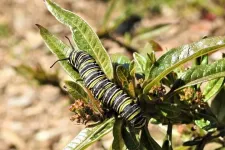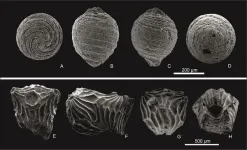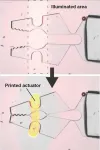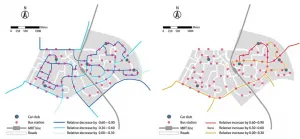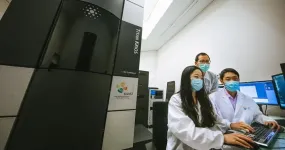(Press-News.org) Seeing through smog and fog. Mapping out a person's blood vessels while monitoring heart rate at the same time--without touching the person's skin. Seeing through silicon wafers to inspect the quality and composition of electronic boards. These are just some of the capabilities of a new infrared imager developed by a team of researchers led by electrical engineers at the University of California San Diego.
The imager detects a part of the infrared spectrum called shortwave infrared light (wavelengths from 1000 to 1400 nanometers), which is right outside of the visible spectrum (400 to 700 nanometers). Shortwave infrared imaging is not to be confused with thermal imaging, which detects much longer infrared wavelengths given off by the body.
The imager works by shining shortwave infrared light on an object or area of interest, and then converting the low energy infrared light that's reflected back to the device into shorter, higher-energy wavelengths that the human eye can see.
"It makes invisible light visible," said Tina Ng, a professor of electrical and computer engineering at the UC San Diego Jacobs School of Engineering.
While infrared imaging technology has been around for decades, most systems are expensive, bulky and complex, often requiring a separate camera and display. They are also typically made using inorganic semiconductors, which are costly, rigid and consist of toxic elements such as arsenic and lead.
The infrared imager that Ng's team developed overcomes these issues. It combines the sensors and the display into one thin device, making it compact and simple. It is built using organic semiconductors, so it is low cost, flexible and safe to use in biomedical applications. It also provides better image resolution than some of its inorganic counterparts.
The new imager, published recently in Advanced Functional Materials, offers additional advantages. It sees more of the shortwave infrared spectrum, from 1000 to 1400 nanometers--existing similar systems often only see below 1200 nanometers. It also has one of the largest display sizes of infrared imagers to date: 2 square centimeters in area. And because the imager is fabricated using thin film processes, it is easy and inexpensive to scale up to make even larger displays.
Energizing infrared photons to visible photons
The imager is made up of multiple semiconducting layers, each hundreds of nanometers thin, stacked on top of one another. Three of these layers, each made of a different organic polymer, are the imager's key players: a photodetector layer, an organic light-emitting diode (OLED) display layer, and an electron-blocking layer in between.
The photodetector layer absorbs shortwave infrared light (low energy photons) and then generates an electric current. This current flows to the OLED display layer, where it gets converted into a visible image (high energy photons). An intermediate layer, called the electron-blocking layer, keeps the OLED display layer from losing any current. This is what enables the device to produce a clearer image.
This process of converting low energy photons to higher energy photos is known as upconversion. What's special here is that the upconversion process is electronic. "The advantage of this is it allows direct infrared-to-visible conversion in one thin and compact system," said first author Ning Li, a postdoctoral researcher in Ng's lab. "In a typical IR imaging system where upconversion is not electronic, you need a detector array to collect data, a computer to process that data, and a separate screen to display that data. This is why most existing systems are bulky and expensive."
Another special feature is that the imager is efficient at providing both optical and electronic readouts. "This makes it multifunctional," said Li. For example, when the researchers shined infrared light on the back of a subject's hand, the imager provided a picture of the subject's blood vessels while recording the subject's heart rate.
The researchers also used their infrared imager to see through smog and a silicon wafer. In one demonstration, they placed a photomask patterned with "EXIT" in a small chamber filled with smog. In another, they placed a photomask patterned with "UCSD" behind a silicon wafer. Infrared light penetrates through both smog and silicon, making it possible for the imager to see the letters in these demonstrations. This would be useful for applications such as helping autonomous cars see in bad weather and inspecting silicon chips for defects.
The researchers are now working on improving the imager's efficiency.
INFORMATION:
Paper title: "Organic Upconversion Imager with Dual Electronic and Optical Readouts for Shortwave Infrared Light Detection." Co-authors include Naresh Eedugurala and Jason D. Azoulay, University of Southern Mississippi; and Dong-Seok Leem, Samsung Electronics Co., Ltd.
This work was supported by the National Science Foundation (ECCS-1839361) and Samsung Advanced Institute of Technology. The work was performed in part at the San Diego Nanotechnology Infrastructure (SDNI) at UC San Diego, a member of the National Nanotechnology Coordinated Infrastructure, which is supported by the National Science Foundation (grant ECCS-1542148).
A new Tel Aviv University study has revealed, for the first time, that bats know the speed of sound from birth. In order to prove this, the researchers raised bats from the time of their birth in a helium-enriched environment in which the speed of sound is higher than normal. They found that unlike humans, who map the world in units of distance, bats map the world in units of time. What this means is that the bat perceives an insect as being at a distance of nine milliseconds, and not one and a half meters, as was thought until now.
The Study was published in PNAS.
In order to determine ...
PULLMAN, Wash. -- A count of the Western Monarch butterfly population last winter saw a staggering drop in numbers, but there are hopeful signs the beautiful pollinators are adapting to a changing climate and ecology.
The population, counted by citizen scientists at Monarch overwintering locations in southern California, dropped from around 300,000 three years ago to just 1,914 in 2020, leading to an increasing fear of extinction. However, last winter large populations of monarchs were found breeding in the San Francisco and Los Angeles areas. Prior to last winter, it was unusual to find winter breeding by monarchs ...
The idea of deriving health benefits from live microorganisms is well known, but some non-living microorganisms, too, can have beneficial health effects. Yet even with an increasing number of scientific papers published on non-viable microbes for health, the category is not well defined and different terms are used in different contexts.
Now, a group of international experts has clarified this concept in a recently END ...
A study published in Cretaceous Research expands the paleontological richness of continental fossils of the Lower Cretaceous with the discovery of a new water plant (charophytes), the species Mesochara dobrogeica. The study also identifies a new variety of carophytes from the Clavator genus (in particular, Clavator ampullaceus var. latibracteatus) and reveals a set of paleobiographical data from the Cretaceous much richer than other continental records such as dinosaurs'.
Among the authors of the study are Josep Sanjuan, Alba Vicente, Jordi Pérez-Cano and Carles Martín-Closas, members of the Faculty of Earth Sciences and the Biodiversity Research Institute (IRBio) of the University of Barcelona, in collaboration with the expert Marius Stoica, ...
Ishikawa, Japan - Inside our cells, and those of the most well-known lifeforms, exist a variety of complex compounds known as "molecular motors." These biological machines are essential for various types of movement in living systems, from the microscopic rearrangement or transport of proteins within a single cell to the macroscopic contraction of muscle tissues. At the crossroads between robotics and nanotechnology, a goal that is highly sought after is finding ways to leverage the action of these tiny molecular motors to perform more sizeable tasks in a controllable manner. However, achieving this goal will certainly be challenging. "So far, even though researchers ...
Singapore, 5 May 2021 - The rapid advancement of Autonomous Vehicles (AV) technology in recent years has changed transport systems and consumer habits globally. As countries worldwide see a surge in AV usage, the rise of shared Autonomous Mobility on Demand (AMoD) service is likely to be next on the cards. Public Transit (PT), a critical component of urban transportation, will inevitably be impacted by the upcoming influx of AMoD and the question remains unanswered on whether AMoD would co-exist with or threaten the PT system.
Researchers at the Future Urban Mobility (FM) Interdisciplinary Research Group (IRG) at Singapore-MIT Alliance for Research and Technology (SMART), MIT's research enterprise in Singapore, and Massachusetts ...
The inner workings of a "self-destruct switch" present on human cells that can be activated during an immune response have been revealed. In unprecedented detail, KAUST scientists with collaborators in China report the 3D atomic structure of the human PANX1 protein, which may help underpin new therapies that target the immune system.
When cells become infected with a pathogen, the body's immune system works to destroy the infected cells before they become a threat to surrounding tissues. This form of cell death, during which a cell releases potent ...
The first civilisations to build monumental palaces and urban centres in Europe are more genetically homogenous than expected, according to the first study to sequence whole genomes gathered from ancient archaeological sites around the Aegean Sea. The study has been published in the journal Cell.
Despite marked differences in burial customs, architecture, and art, the Minoan civilization in Crete, the Helladic civilization in mainland Greece and the Cycladic civilization in the Cycladic islands in the middle of the Aegean Sea, were genetically similar during the Early Bronze age ...
We live in times when among the most limited and precious resources on Earth are air and water. No matter the geographical location, the pollution spreads quickly, negatively affecting even the purest regions like Mount Everest. Thus, anthropogenic activity decreases the quality of the environment, making it harmful for flora and fauna. Current waste treatment methods are not sufficient, so novel and effective methods for maximizing pollutants removal are highly needed. One of the robust and prosperous solutions that make it possible to degrade various highly toxic chemicals from air and water is based on nanotechnology. Nanomaterials offer unique physicochemical properties, ...
Coral are not completely defenceless against attacking juvenile crown of thorns starfish and can fight back to inflict at times lethal damage, new research has found.
This occurs during a period of the crown of thorns starfish life cycle, where small juveniles shift from a vegetarian diet of algae to coral prey. But this change in diet makes the juveniles more vulnerable to attack by coral.
Population outbreaks of adult crown of thorns starfish, alongside coral bleaching is one of the greatest threats to tropical reef habitats.
Video footage shows when the tube feet (small tube-like projections on the underside of a starfish's arm used for movement) of juvenile crown ...

